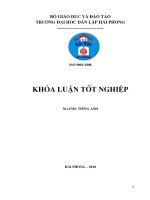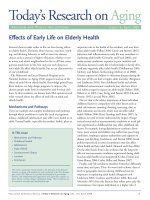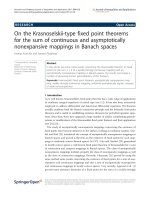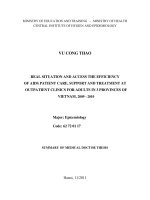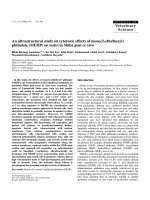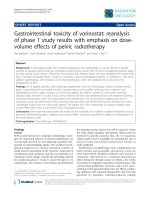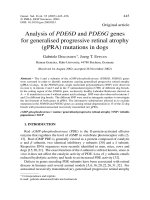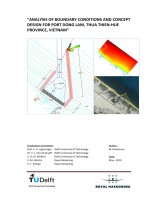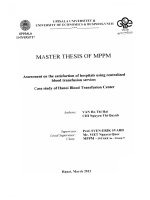current conditions and assessment on the effects of the caring, supporting and treating activities for aids patients at adult outpatient clinics in 3 provinces of vietnam, 2009 - 2010
Bạn đang xem bản rút gọn của tài liệu. Xem và tải ngay bản đầy đủ của tài liệu tại đây (235.42 KB, 27 trang )
MINISTRY OF EDUCATION AND TRAINING - MINISTRY OF HEALTH
CENTRAL INSTITUTE OF HYGIEN AND EPIDEMIOLOGY
VU CONG THAO
REAL SITUATION AND ACCESS THE EFFICIENCY
OF AIDS PATIENT CARE, SUPPORT AND TREATMENT AT
OUTPATIENT CLINICS FOR ADULTS IN 3 PROVINCES OF
VIETNAM,
2009 - 2010
Major: Epicemiology
Code: 62 72 01 17
SUMMARY OF MEDICAL DOCTOR THESIS
Hanoi, 11/2011
2
The work is completed at: Central Institute of Hygiene and Epidemiology
The science supervisor:
1. Ass.Pro.Dr Nguyen Thanh Long
2. Ass.Pro.Dr Ho Ba Do
Objection 1:
Objection 2:
Objection 3:
The thesis will be defenced at the State Council of thesis mark in Central Institute
of Hygiene and Epidemiology
at , date month year
The thesis can be serached at:
1. National library
2. The library of National Institute of Hygiene and
Epidemiology
3
LIST OF THE AUTHORS’ ANNOUNCED RESEARCH
WORK RELATED TO THE THESIS
________________________
1. Vu Cong Thao, Nguyen Thanh Long, Ho Ba Do, (2011) “Some features and
demand of care, support and treatment of the infected at the non-resident clinics in
3 privinces of Vietnam in 2009”, Preventive Medical Magazine– Special issue for
Vietnam Teacher Day, November 20
th
and 2011’s postgraduate science conference
of postgraduate training bases, Central Institute of Hygiene and Epidemiology
. File
XXI, No. 7 (125). pp. 148 – 154.
2. Vu Cong Thao, Nguyen Thanh Long, Ho Ba Do and et al (2011), “Some comments
on HIV/AIDS patient treatment by ARV at 3 outpatient clinics in Vietnam, 2009-
2010”, Vietnam Medical Megazine – File 388, No. 1, December 2011. pp.30 – 34.
4
INTRODUCTION
It has been 30 years since the world confronted with HIV/AIDS epidemic. In
spite of many achievements in medicine, biology, sociology, media education
information, community mobilization, etc in the field of HIV/AIDS prevention, it is
not strong enough to prevent the HIV/AIDS epidemic’s attack. Especially, in the
developing countries where the source for diagnosing, treating, monitoring and
managing HIV/AIDS infected patients is limited, HIV/AIDS is still the issue of top
concern of public and social health.
To limit spreading the HIV/AIDS epidemic and prolong the life for the
patients, a lot of methods such as education propaganda to increase the awareness,
understading on HIV for the community, provision treatment, potential infection
treatment, anti-retrovirus medicine (ARV) for infected persons were conducted.
Among above methods, caring, supporting and treating by ARV medicine play an
important role. Although ARV medicines do not completely treat HIV/AIDS, it
significantly reduces the diseases and death, prolong and improve meaningful life for
many patients with AIDS.
In Vietnam, in order to meet HIV epidemic prevention, in 2000, Ministry of
Health issued national instructions on HIV/AIDS dignosis and treatment, which were
supplemented and amended in 2005, 2009. Ministry of Health also had the plan to
classify the treatment by establishing outpatient clinic in provinces, cities. HIV/AIDS
infected people can register to be freely cared and treated at one of these clinics.
Treatment extension by ARV and treatment monitor in outpatient clinics have been
conducted since March, 2006 with the support of the projects of global fund,
American President’s urgent assistance fund (Pepfar), Bill-Clinton Fund, etc. This
treatment implementation brought the hope and future for a lot of HIV/AIDS
infected persons, and timely prevent HIV infection for the potential subjects and
community.At these clinics, HIV/AIDS infected persons are provided with a lot of
essential services: Adequately consulted to ensure complying with the treatment with
high efficiency, discrimination reduction, community intergration, etc and create
conditions for HIV/AIDS infected persons to obtain many chances to live, self-work,
self-care, reduce the burden for the family and society.
5
After 6 years of outpatient clinic development, as of 30/6/ 2011, the whole
nation had 54.637 AIDS patients who were managed and treated by anti-retrovirus
medicine (ARV) . It is very issential to evaluate the efficiency of AIDS patient care,
support and treatment at the outpatient clinics and then extend the program to meet
AIDS patients’ increasing demand of care, support and treatment.
Starting from above base, in the framework of the project “ Provision and
care for the HIV/AIDS infected persons in Vietnam – Life-Gap” by Ministry of Health
and Department of HIV/AIDS prevention, we conduct to research the theme: "Real
situation and efficiency evaluation of AIDS patient care, support and treatment at the
adults’ outpatient clinics in 3 provinces of Vietnam, 2009-2010” with the targes:
1. Describe real situation and some factors related to supplying the services
of AIDS patient care, support and treatment in the adults’ outpatient clinics
in 3 provinces/cities: Hanoi, Nghe An, Ho Chi Minh City.
2. Assess the efficiency of AIDS patient care, support and treatment
management in the adults’ outpatient clinics at the place of research.
* New contributions of the thesis:
- Describe operation situation of outpatient clinic models and services supplied
for the patients by outpatient clinics and efficiency of AIDS patient treatment
by anti-retrovirus medicine (ARV) as well as several factors related to the
outpatient clinics’s care, treatment support.
- The model of outpatient clinics associated with available medical bases is
proved to obtain good efficiency, in appropriateness with the nations which
have public health network like Vietnam. The research result is the scientific
base to support the State Agencies on HIV/AIDS prevention and for the
projects, the donars have basses to adjust the activities more appropriate and
effective.
* The thesis’ structure: The thesis including 120 pages (excluding the appendixes,
table of contents, abbreviations) constitues into 4 chapters:
- Introduction: 2 pages
- Chapter 1. Overview: 33 pages
- Chapter2. Subject and research method: 21 pages
- Chapter 3. Result: 38 pages
- Chapter 4. Discussion: 23 pages
- Conclusion: 2 pages
- Recomendation: 1 page
- The thesis include: 37 tables, 10 maps
6
- Reference: 137
CHAPTER I
OVERVIEW
1.1 Real situation of HIV/AIDS infection
According to the report at the end of year 2010 by UNAIDS and WHO, the whole
world has about 70 million of infected people, 30 million of dead persons and currently,
there are about 40 million persons with HIV/AIDS. Each day, there is further about 7.000
new infected persons (of which, there are 6.000 adults and 1.000 children), 95% new
infected cases occurs in slowly developing or developing nations, mainly in African
nations nearly Sahara, then it extends to East-South countries. HIV/AIDS ranks the fourth
among the causes leading to the dealth in African countries. The women accounts for over
50% of total persons infected with HIV in the whole world. Among 70 million persons
infected with HIV in the world, 45% are at the youth age of 15-24 years old.
The first HIV/AIDS infected case in Vietnam is detected in December, 1990 in
Ho Chi Minh City. As of 30/6/2011, according to the report of Vietnam HIV/AIDS
Prevention Department, the number of detected HIV infected cases is 190.902
persons who are alive; of which, there are 46.056 AIDS patients and 108 persons died
due to HIV/AIDS. The current infection rate is 224,6/100.000 people.
1.2. Situation of HIV/AIDS infected patient care, support and treatment
The HIV/AIDS infected patient care, support and treatment is considerred to be
the focus of AIDS control and prevention. Care, support and treatment reduce the
pain of physical and spiritual state, help to prolong the life and enhance life quality
for HIV/AIDS infected persons. Zămbia is one of the first African nations which
implement the HIV infected patient care service at home. This service was
internationally recognized because of high quality. Currently, it is estimated that the
whole world has 32,3 HIV infected persons who are alive and mainly gather in
developing countries. High efficiency HIV virus resistance treatment medicine
support (started to implement in 1996) opened new prospects, bringing the hope to
prolong the life for HIV/AIDS infected persons. Up to now, several other nations un
the region of Thai Binh Duong’s west established the base for extending HIV
resistance treatment with the Government’s strong commitment in steering, finance
and active participation of boards, sectors, unions in the society.
In Vietnam, currently, the system of HIV infected person care and support in the
community which was initiated since 1996, with the program of management, care and
consulting in 3 provinces, cities was implemented in the whole country. The outpatient
clinics, voluntary test room (VCT) were established in combination with consulting
HIV test, including the provision for HIV infection from mother to children (PLTMC)
in 40 provinces. In addition, to gain the target that HIV infected persons can get easy
access to the services of care, support and treatment, with the support of Global Project
on HIV/AIDS, Ministry of Health conducted the model of care, treatment support in
7
100 districts of 20 provinces, of which, there are 60 outpatient clinics at the district
level which conducted AIDS treatment by HIV resistance medicine.
CHAPTER II
RESEARCH SUBJECT AND METHOD
2.1. Research subject, place and time
2.1.1 Research subject
- AIDS infected adults (identified ≥ 18 years old).
- The Health staff directly participate in AIDS patient care and treatment at the
outpatient clinics and in the community.
- Colleagues, co-ordinators.
- AIDS patient’s relatives: Father, mother, wife/husband, brothers, sisters.
- Reports on HIV/AIDS by Ministry of Health of 3 research provinces/cities;
AIDS’s medical document of AIDS patient participating in the research.
2.1.2 Research place
The research is conducted with clear purpose in 3 outpatient clinics supplying
the service of care, support and treatment for AIDS infected adults in 3 provinces,
cities: Ha Noi, Nghe An and Ho Chi Minh.
The outpatient clinics in researched provinces which are choosen to participate
researching on the convient base are the ones supplying the ARV treatment services
at least 1 years. At least, there are 300 patients who are cared, supported and treated
with ARV medicine.
2.1.3 Research time: Conduct to investigate, intervene for researched subjects
from 6/2009 to 12/2010.
- The first investigaiton: 6/2009 - 9/2009 (Research real situation description).
- The second investigation: 10/2010 - 12/2010 (Access after treatment
intervention by ARV medicine).
2.2 Research method
2.2.1 Design research
Is the description research method including analysis (combine the quantitative
and qualitative) and clinic intervention research in comparison with before and after-
intervention.
2.2.2 Research method
- Method of cross description investigation
- Method of secondary data analysis
- Method of deep interview, group discussion
- Method of clinic test with the comparison.
2.2.4 Research sample
2.2.4.1 Quantitative research
Size for desdription research calculated according to the fomula of minimal
calculation of epidemiology research method describes:
p(1 – p)
8
n
1
= Z
2
(1-α/2)
x
__________________
(p.ε)
2
n
1
: Minimal sample size; α: Statistic meaning level(0,05); p: the rate of
managed HIV/AIDS infected persons (p=0,5 for maximal sample size); Z
(1-α/2)
:
Confidence coefficient with desired confidence of 95% (Z
(1-α/2)
= 1,96); ε: Relative
value (ε = 0,1); Because of choosing sample with clear target, multiply with DE =
2 sample design influence coefficient; it is estimated that the rate of research refuse
is 105. With above-mentioned parameters, sample size for research is 844, in
reality, when conducting the research, 100 AIDS patients of each outpatient clinics
are taken into the research; therefore, total number of research subjects is 900.
Sample size for clinical trial study: Assess the effectiveness of intervention, the
size was calculated basing on the form to calculate the radix of noncontrolled cohort
study.
[(1 – p
1
)/p
1
+ (1 – p
2
)/p
2
]
n
2
= Z
2
(1-α/2)
______________________________________
[ℓn(1 – ε)]
2
n
2
: sample size of clinical trial study; Z
(1-α/2)
: confidence coefficient, with
desired reliability was 95% (Z
(1-α/2)
= 1,96); P
1
: Rate of AIDS patient being taken
cared of, supported before intervention p
1
= 35% = 0,35; P
2
: Rate of AIDS patient
being taken cared of, supported after intervention p
2
= 80% = 0,8; ε: Relative
accuracy (Acceptale error), at 10%; expecting the rate of patient reusing to take part
in the study is 10%. With the above parameters, n
2
= 730 as the common sample size
calculated for all three outpatient clinic. In studying, we took 300 AIDS patients
from each outpatient clinic; total number of studying subjects was 900.
2.2.4.2 Qualitative study
In each clinic, choose 5 subjects for intensice interview (total number of
interview was 15) and 20 subjects for focused group discussion (each group included
8-10 people, one group of AIDS patient; 1 group for officers, medical staff in the
clinic and caring people). In fact, there were 75 subjects taking part in this study.
2.2.5 Sample choosing method
2.2.5.1 Desciption of studying subject
* Quantitive study: Choose sample intentionally, in each province or city, choose 1
outpatient clinic the number of AIDS being managed, cared and supported and
treated >300, data was collected from a random sample of 300 patients. In practical
studying, because the sample was chosen on purpuse, outpatient clinic taking part in
the study all have sufficient amount of AIDS patient of 300. Total number of patients
taking part in the study is 900.
* Qualitative study: Subjects taking part in group discussion were chosen
intentionally, especially AIDS patients chosen among 300 subjects taking part in the
quantitive study. Subject taking part in the interview were chosen intentionally.
2.2.5.2 Subject of clinical intervention study
9
Studying subjects are AIDS patients studied in stage were patient using ARV
medicine of the management board of province, city and district choose until the
sample size is 300 for each clinic and were minitored continuously in 1 year.
2.2.6 Equipment to collect studying information, indexs and enrolls
Set of studying indexes includes 5 parts with 43 indexes in order to describe
actual situation, related factors and assess effectiveness of AIDS patient caring,
supporting and treatment managing activities before and after treatment with ARV.
Table of group discussion and intensive interview instruction
Table of equipment and facility checking
Effectiveness indicator, to compare increasing effectiveness before and after
intervention in percent, calculated as following:
׀Indicator before intervention - Indicator before intervention ׀
Effectiveness indicator =
____________________________________________________________
x 100
Indicator before intervention
2.2.7 Data collecting method
The data was collected by: testing table, cross-sectional survey, medical record,
AIDS monitoring and caring book, clinical test result of hematology, biochemical,
microbiological basing on studying indexes
2.3. Data processing
The data were entered with EPI-Info software, SAS program were used to
compare and deal with any dissimilarity between 2 data. After data entering, data sets
were transferred to STATA software version 8.2 (Stata Corp, 2004).
2.5. Limitation of the topic
2.5.1. Topic range
Studying location of the topic was chosen interntionally, not really representing
provincces, citites, areas with morphological features as well as socio-economic
condition of each area.
Outpatient clinics chosen were clinics financed from projects; then the studying
results may not reflect actual situation of HIV/AIDS patient caring, supporting and
treating activities currently.
2.5.2 Topic limitation
The topic is performed in narrow range, not representative, studying subjects
were chosen interntionally without randomness. The cohort studying was applied for
clinical intervention studying but without control
2.5.3. Overcome topic limitation
- Investigators and supervisors were chosen and trained consistently in term of
studying method, tested tools and practised investigating skills (trial investigating)
- The investigating process was supervised closely by field work supervision and
quality control survey as well as medical records.
2.6 Morality in studying
Only study subjects that agreed to take part in. Information, data is ensured to
be confident and only support for studying purpose. The studying result is used to
10
built up and adjusted intervention content for HIV and AIDS patients more and more
effectively, helping other HIV / AIDS patients in the studying territory to get benifits
directly or indirectly from the program.
CHAPTER 3
STUDYING RESULTS
3.1. Actual situation and some factors related to supplying of caring, supporting
and treating services to AIDS patient in outpatient clinic for audults in studying
location
3.1.1. Actual situation of supplying of caring, supporting and treating services to
AIDS patients in in outpatient clinic for audults in studying location
Outpatient clinic for audults in studying location had sufficient working room
as regulated, including: welcoming room, examiniation room, blood testing room,
medicine room, consulting room, administration room; in average, there wee 5,6
rooms/ outpatient clinic. Officers, staff of outpatient clinics included: doctors, nurse,
consultants, technicians, ppharmaceutical workers, supporting staff, other staff; in
average, there were 16 officers , staff / outpatient clinic.
Outpatient clinic in studying location were also supported by peers (HIV/AIDS
patients, drug addictors, prostitutes) and coordinators. In average, there were 27.3
peers and 28.3 coordinator supporting the outpatient clinics in studying location.
8,2
85,6
6,2
0
20
40
60
80
100
Quantity
1-2 times 3-6 times >6 times
Rate (%)
Diagram 3.1 Number of times that AIDS patients taking part in the training
100% of studied patients were trained before taking part in the ARV treatment; in
that 85.6% took part in the training 3-6 times, 6 took part in more than 6 times.
3.1.2. Some factors related to supplying of caring, supporting and treating services
to AIDS patients in outpatient clinics for adults in studying location.
3.1.2.1. Characteristics of studied patients before intervention
32.6% of AIDS patients at the age of 20-29, while those at the age of 30-39 are
54.5%. Male patients still accounted for majority with 72.8% while female ones
accounted for 27.2%. Studied subject with low education (from primary school
downward) accounted for 15.1%. There was a difference between high school level,
college and university between Nghe An and two cities of Ho Chi Minh city and
Hanoi (High school in Hanoi 44.5%, Ho Chi Minh city 38.8%, Nghe An 16.4%).
54.5% of AIDS patients have had husband or wife, the rest (45.5%) was not
married or divorced, widow or judicially separated. 71.1% of studied subjects lived
11
with their parents, husband or wife; 28.9% lived with their friends, alone or homeless.
Rate of unstable job or unemployment was high: 72.9%, driver accounted for 16.3%,
worker: 6.3%; officer: 4.5%.
The rate of AIDS patients taking part in the study who did not define the risk of
infection was high at 25.2%. 74.8% defined the risk, in which infection through grug
injecting was 43.4% and through sex was 29.4%
Table 3.8 Unit introduced patients to outpatient clinic
Studying location
Introduction unit
Hanoi
(n= 300)
Nghe An
(n= 300)
HCM city
(n= 300)
Total
(n= 900)
(%) (%) (%) (%)
- Voluntary laboratory
- Community outreach group
- Other outpatient clinics
- Know – themselves
- Others
- Non-defined
6,3 23,7 35 21,7
4,0 0,0 3,3 2,4
18,3 21,7 12,7 17,6
62,0
*
4,7
**
35,7
***
34,1
8,0 44,3 7,0 19,8
1,3 5,7 6,3 4,4
*&**: OR = 33,3, 95%CI (18,2 - 64,4), p<0,01;
***&**: OR = 11,3, 95%CI (6,2 - 21,9), p<0,01
Result in table 3.8 shows that: AIDS patients were managed, cared and treated in
outpatient clinics introduced by consulting room; voluntary laboratory account for
about 21.7%, by other outpatient clinics accounted for 17.6%, this ratio shows the role
of outpatients to HIV/AIDS patients. Up to 34.1% of patient came to outpatient clinics
voluntarily to be treated and there is a statistic difference between big city with
provinces (Hanoi and Nghe An: OR = 33,3 , 95%CI (18,2 – 64,4), p<0,01; Ho Chi
Minh city and Nghe An: OR = 11,3 , 95%CI (6,2 – 21,9), p<0,01), this also shows that
they were aware of self-caring and studying related information themselves.
3.1.2.2 Understanding of studying patient before intervention
Table 3.9 Knowledge about ARV
Content Frequency
(n = 900)
Rate
(%)
Right
understanding
about ARV
- Antibiotics 19 2,1
- HIV anti-retroviral drug 872 96,9
- No answer 9 1,0
ARV is combined
from
- From the two above drugs 37 4,1
- At least from 3 drugs upward 835 92,8
- No answer 28 3,1
96.9% of the research patients understood that ARV is HIV antiretroviral
medicine; 2.1% of the research patients thought that ARV is an antibiotic medicine,
and 1.0% did not understand what ARV was.
12
When we asked the patients about the composition of ARV, 92.8% the
research patients thought that it consisted of at least 3 types of medicines, 4.1%
thought that ARV consisted of 2 types of medicines, and 3.1% of the research
patients did not know about the composition of ARV.
Table 3.10 Knowledge about Time of Treatment and way to take ARV
Content
Frequency
(n = 900)
Rate
(%)
Time of treatment with ARV
- Until the health gets better 9 1.0
- Long life treatment 872 96.9
- Do not know 19 2.1
Way to take ARV
- Take ARV 2 times/day 900 100.0
- Time between the 2 dosages: 12 hours 900 100.0
Almost all the research patients understood that ARV is for long-life treatment
(accounting for 96.9%). However, 2.1% of the research patients did not know about
the time of ARV treatment. 1.0% thought that the treatment with ARV would finish
until their health got better. 100% of the research patients understood that during the
ARV treatment, they should take the ARV 2 times/day and that the time between the
2 dosages is 12 hours.
Table 3.11 Knowledge about the side effects of ARV
Knowledge about the side effects of ARV
Frequency
(n = 900)
Rate
(%)
Side effects
- Yes 732 81.4
- No 168 18.6
Symptoms of
side effects
- Rash
683 75.9
- Jaundice
296 32.9
- Vomiting
330 36.7
- Diarrhea
239 26.5
- Abdominal pain
171 19.0
- Headache
274 30.4
- Dizziness and vertigo
410 45.6
- Others
57 6.3
Only 81.4% of the research patients understood the side effects of ARV and
showed the side effects during the ARV treatment. The most mentioned symptom is
Rash (75.9%); Dizziness and vertigo (45.6%); Vomiting (36.7%).
13
Diagram 3.3 Knowledge about treatment compliance
Almost all the research patients understood that treatment compliance was to
take the ARV on time (94.8%), take ARV with specified amount (86.6%) and take
the right medicine (81.4%).
Table 3.12 Knowledge about treatment non-compliance
ARV treatment non-compliance Frequency
(n = 900)
Rate
(%)
- Skip 1 dosage among the specified dosages 650 72.2
- Skip 1 day without taking the medicine 612 68.0
- Do not care about the time between the dosages 492 54.7
- Do not know 9 1.0
72.2% of the research patients considered treatment non-compliance as skipping
1 dosage among the specified dosages; skipping 1 day without taking the medicine
(68.0%), and Do not care about the time between the dosages (54.7%). Only 1% of
the research patients did not know what should be consider as treatment non-
compliance.
Table 3.14 Knowledge about taking additional missed medicine and the
supporting measures for treatment compliance
Contents
Frequency
(n = 900)
Rate
(%)
Take
additional
missed
medicine
- Take the missed dosage immediately
and count the time for the next dosage
744 82.7
- Skip the missed dosage and take the next
dosage as usual
146 16.3
- Do not know 9 1.0
Supporting
measures for
treatment
compliance
- Make the plan on my own 691 76.8
- Cooperate with the supporters 398 44.2
- Notify the health officers 360 40.0
- Do not know 19 2.1
14
When the research patients missed to take one dosage, most of them thought that
the missed dosage ought to be taken immediately and count the time for the next
dosage (82.7%), 16.3% of them skip the missed dosage and take the next dosage as
usual, 1.0% of them did not know what to do when they missed one dosage.
Most of the research patients understood the supporting measures for treatment
compliance: Make plane by themselves (76.8%), cooperate with the supporters (44.2%),
and notify the health officers (40.0%).
61,9
38,1
0
20
40
60
80
Pass Fail
Level
Rate (%)
Diagram 3.4: General knowledge about ARV treatment compliance
Only 61.9% of the research patients passed the test for General knowledge about
ARV treatment compliance, 38.1% did not pass the test.
3.1.3. Conditions of the research patients before the ARV treatment
72.8% of the research patients had the history of opportunistic infections.
27.2% the research patients did not have the history of opportunistic infections, the
highest rate: shingles (9.6%), following by: tuberculosis (8.4%), oral candidiasis:
(6.0%), the lowest rate: Retinitis due to CMV (0.2%).
84.8% of the research patients did not have the history of tuberculosis. Among
15.6% of the research patients with the history of tuberculosis, 11.2% were being
treated, 4.4% of then had been treated. 71.1% of them got pulmonary tuberculosis,
26.7% got extrapulmonary tuberculosis.
Table 3.17 History of ARV preventive treatment and treatment of the research patients
Research Location
History
Hanoi
(n= 300)
Nghe An
(n= 300)
HCM
(n= 300)
Total
(n= 900)
(%) (%) (%) (%)
Cotrimoxazole (preventive )
- Yes 48.7 93.7 48.3 63.6
- No 51.3 6.3 51.7 36.4
Fluconazole (preventive )
- Yes 45.7 33.7 43.7 41.0
- No 54.3 66.3 56.3 59.0
Have used ARV before
- Yes 16.7 4.0 14.0 11.6
- No 83.3 96.0 86.0 88.4
15
11.6 % of the research patients had used ARV before registering at the
outpatient clinics. 63.6% had received the preventive treatment with Cotrimoxazole.
41.0% had received preventive treatment with fluconazole. The result did not show
the number of patients who received preventive treatment with such 2 type of
medicines and the rate of patients who did not received the preventive treatment.
Diagram 3.5 Type of ARV treatment of the research patients before registering
at the outpatient clinics.
Among 99 research patients who had received ARV treatment before registering
at the outpatient clinics, 58.6% used ARV by themselves; only 16.2% were treated at
other outpatient clinics, 3.0% were treated at private clinics.
There are 5 types of ARV treatment regimens for the AIDS patients before
registering at the outpatient clinics. The most popular regimen is d4T/3TC/NVP
(57.7%), following by d4T/3TC/EFV (20.8%); the least popular regimen is
ZDV/3TC/LPV/R (1.0%). Other type of treatment accounts for 9.6%, and 5.8% could
not identify the regimen.
Table 3.20: Opportunistic infection status of the researched patients before AVR
treatment.
Research place
Status
Hanoi
(n= 300)
Nghe An
(n= 300)
HCM city
(n= 300)
Total
(n= 900)
(%) (%) (%) (%)
With opportunistic infection 64,3 58,0 58,0 60,1
Without opportunistic infection 35,7 42,0 42 39,9
- Stomatomycosis 27,0 22,0 16,7 21,9
- Pneumonia PCP 0,3 2,3 0,3 1,0
- Toxoplasma Infection 0,7 0,7 0,0 0,4
- Penicillium marneffei 1,0 4,0 0,3 1,8
- Retinitis by CMV 0,0 0,3 0,0 0,1
- Tuberculosis 3,7 12,0 21,0 12,2
- Zona 2,0 2,3 2,3 2,2
- Other 5,3 6,3 26 9,2
16
Before ARV treatment, 60.1% the researched patients do not have
opportunistic infection. Among 39.9% the researched patients have the opportunistic
infection, rate of Stomatomycosis is the highest (21.9%), the next is Tuberculosis
(12.2%), Zona (2.2%) and retinitis by CMV is rank the lowest (0.1%).
3.1.4 Subclinical indicator before ARV treatment of the the researched patients.
83% the researched patients (743/895) have test result CD4 before ARV treatment
in outpatient clinic, of which CD4 level of them is mainly low <100 cells accounting for
57.3%, CD4 from 100 to 200 cells: 27.7%. The researched patients have CD4 indicator
>300 cells: 6.3% and >500 cells: 1.6%.
90.4% (809/895) the researched patients have test result liver intoxication
before ARV treatment, of which, most of them is at medium level: 53.3%; minor
level: 41.9%. The number of patients at serious level is low, accounting for 1.1%, the
patients at extremely serious level: 0.2%.
Anemias extend of the researched patients before ARV treatment: 53.4%
patients have Hgb test result, of which, most of them are at medium level: 83.5%, the
number of patients are at serious level: 0.6% and extremely serious level (can
threaten their life): 2.5%.
65.7% (588/895) the researched patients have test results about kidney impairment
(Creatine indicator – mg/dl), the patients having medium level account for 95.9%, I
level (minor): 4.1%. None is at level II, III and IV.
3.2 Effectiveness of caring, assistance and treatment management activities for
the AIDS patients in the adult outpatient clinic in the research place
3.2.1 The result of caring, assistance and treatment management activities for the
AIDS patients
Table 3.26 Result of consultation, assistance activities for the AIDS patients
Research place
Content
Hanoi
(n = 300)
Nghe An
(n = 300)
HCM city
(n = 300)
Total
(n = 900)
• Group consulting
- Number of day
- Number of patient taking part
25
521
18
438
27
544
70
1.503
• Personal consulting 729 653 648 2.030
• Consulting at family,
community
1.925 1.422 1.789 5.136
• Re-examination 2596 2845 2634 8.075
The caring, assistance and treatment management activities for the AIDS patients in
the research place are complemented under the regulations. In average, the researched
patients take part in 1.67 (1,053/900) times of group counsulting; personal consulting
is 2.25 times (2030/900), the lowest level is Nghe An: 1.58 times; consulting in
community is 5.7 times (5136/900) and re-exammination is 8.97 times (8057/900),
the highest level is Nghe An: 9.48 times.
17
Table 3.27 Initial ARV treatment regimen of the patients in the research place.
Reseach place
Type of regimen
Hanoi
(%)
Nghe An
(%)
HCM city
(%)
Total
(%)
1. d4T/3TC/NVP 75,3 73,3 45,3 64,7
2. d4T/3TC/EFV 20,7 18,3 36 25
3. ZDV/3TC/NVP 4 7 11,3 7,4
4. ZDV/3TC/EFV 0 1 6,3 2,4
5. TDF/3TC/LPV/R 0 0,3 0 0,1
6. Other 0 0 0,7 0,2
7. Not given 0 0 0,3 0,1
The initial ARV treatment regimen at the outpatient clinic of the the researched
patients is degree I regimen, mainly regimen with Lamivudin (3TC): 99.7%.
Associating d4t: 89.7% and Associating ZDV: 10.0%. 0.1% patients are treated under
inexplicit regimen.
5.3% the researched patients have interruption of treatment. Most of them have
time I interruption: 85.4%. Cause of this mainly is acute side effects: 18.8%, being
treated tuberculosis: 12.5%, other causes: 60.4%. None have interruption of treatment
causing by treatment failure or end of drugs.
30.4% (272/895) the researched AIDS patients being treated ARV change
treatment regimen. Main cause is acute and chronic side effects: 59.9%; treatment of
tuberculosis: 12.9%; 5.1% patients change their treatment regimen because of ending
of drugs (in Hanoi and Nghe An). 0.7 patients change their regimen because of
treatment failure.
Chart 3.7: Result of management for the researched AIDS patients
After 12 months treatment ARV, the percentage of patients with active
treatment is 75.9%; others: 24.1%, of which: active treatment but stopping ARV:
0.1%, mortality: 10.9%, moving: 8.6% and not control: 4.6%.
Among 41 research subjects which are not control, the cause is moving to
center 06: 7.4%, changing location: 2.4%, mainly inexplicit (56.1%).
18
3.2.2 Effectiveness of caring, assistance and treatment management activities for
the AIDS patients in the research place
Chart 3.8 Effectiveness of caring, assistance activities for the AIDS patients by
their relatives
Support and caring people to the AIDS patients during treatment mainly are
their wife/ husband, father/mother, brother/sister. Percentage of patients being cared,
supported by their relatives after 12 month intervention and treatment ARV virus is
higher than before intervention. Percentage of patients being cared, supported by their
wife/ husband increases the highest: from 41.5% to 67.6%; Percentage of patients
being cared by their brothers/ sisters insignificantly increases: from 18.4% to 19.8%.
Effectiveness indicator is 7.6%, 32.96% and 62.89% respectively.
Chart 3.9: Effectiveness of caring, assistance and treatment management
activities for the AIDS patients in the research place of peers and collaborators.
Percentage of patients being treated by antiviral drug taking part in the research
in the research place who are cared and supported by the peers and collaborators after
12 months of antiviral drug intervention and treatment is higher than that before
intervention, from 22.3% to 44.1% from the peers and from 33.7% to 53.5% from
collaborators, the effectiveness indicator are 97.75% and 39.25% respectively.
19
Chart 3.10: Effectiveness of accessing caring, assistance services for the AIDS
patients in the research place.
The AIDS patients taking part in the research have change in accessing the
caring, assistance services, receive the caring, assistance from the peers and the
collaborators. Percentage of the AIDS patients being treated by antiviral drug taking
part in the research in the research place who are received injection needle, condom,
increases from 43.8% to 51.2% and taking part in club for HIV/AIDS infected people
increases from 21.9% to 38.7%, the effectiveness indicators are 16.68% and 76.7%,
respectively.
3.2.3. Treatment effect of ARV medicine for the researched patients
Table 3.32. CD4 index after ARV treatment of the researched patients
Number of
CD4 cells
Before treatment After 6 months After 12 months
lg (%) lg (%) lg (%)
- < 100 426
*
57,3 63
**
18,3 19
***
6,9
- 100 – 200 202 27,2 131 38,1 93 33,8
- 200 - 300 68 9,2 96 27,9 73 26,5
- 300 - 500 35 4,7 36 10,5 62 22,5
- >500 12
*
1,6 18
**
5,2 28
***
10,2
*
&
**
: OR=6,2 ,95%CI(4,5-8,6), p<0,001;
* *
&
***
: OR=3,0, 95%CI (1,7-5,5), p<0,001.
*
&
**
: OR=3,3, 95%CI (1,5-7,6), p<0,001;
**
&
***
: OR=3,0, 95%CI (1,7-5,4), p<0,001.
After 6 and 12 months of ARV treatment, rates of the patients with the number
of CD4 cells from 100 to 500 are : 76,5% and 82,5%. A number of the patients with
the number of CD4 cells > 500 account for the rate of 5,2% and 10,2%. A number of
the patients with the number of CD4 cells <100 only are 18,3% at the period of 6
months and 6,9% at the period of 12 months after treatment.
When comparing a number of the patients with CD4 <100 and CD4 >500
between before treatment and 6 months of treatment, between after 06 months of
treatment and after 12 months of treatment, the results also show the very close
relation, the positive increase of a number of the patients joining in ARV treatment
and the statistic meaning with p<0,001.
20
Table 3.33. ALT index after ARV treatment of the researched patients
ALT Index
Before
treatment
After 6
months
After 12
months
Lg
(n=900)
Rate
(%)
lg
(n=767)
Rate
(%)
lg
n=683)
Rate
(%)
- Without Test result 91 9,6 418 54,5 365 53,4
- With Test result 809 90,4 349 45,5 318 46,6
Normal <40 UI 431
*
53,3 150
**
43,0 129
***
40,6
Minor 50 - 100 UI 339 41,9 165 47,3 153 48,1
Medium 100 - 200 UI 28 3,5 24 6,9 28 8,8
Serious 200 - 400 UI 9 1,1 10 2,8 6 1,9
Very serious > 400 UI 2 0,2 0 0,0 2 0,6
*
&
**
: OR = 1,5 , 95%CI (1,2 - 1,96), p <0,001 ;
* *
&
***
: OR = 1,1 , 95%CI (0,8 - 1,5), p >0,05
After 6 and 12 months of ARV treatment, the rate of the patients with the liver
intoxication index is mainly at the normal and minor level, in turn : after 6 months
90,3% and 88,7% after 12 months. A number of the patients at the medium and
serious levels have the rates in turn : 9,8% after 6 months ; 10,7% after 12 months.
There are 2 patients with ALT index at the very serious level after 12 months of
treatment, accounting for 0,6%.
After comparing a number of the patient with the normal ALT index (<40UI)
between before treatment and after 6 months of ARV treatment, it shows that there are
the relation in which a number of the patients with the normal index is decreased and
there ate the statistic meanging (p<0,01). There are no relation between after 6 months
of treatment and after 12 months of treatment and no statistic meaning with p>0,05.
Table 3.34. Creatine index (mg/dl) after ARV treatment of the researched
patients
Level
Before treatment After 6 months After 12 months
lg
(n=588)
Rate
(%)
lg
(n=110)
Rate
(%)
lg
(n=96)
Rate
(%)
Normal 0,8 - 1,2 564
*
95,9 109
**
99.1 94
***
97,9
Level 1: < 1,5 24 4,1 0 0 2 2,1
Level 2: 1,5 - 3,4 0 0 0 0 0 0
Level 3a: 3,5 - 5,9 0 0 0 0 0 0
Level 3b: 6,0 - 10 0 0 1 0.9 0 0
Level 4: > 10 0 0 0 0 0 0
*
&
**
: OR = 0,2 , 95%CI (0,5 - 1,3), p>0,05 ;
* *
&
***
: OR = 2,3 , 95%CI (0,1 - 13,8), p>0,05
Kidney impairment level after 6 months and 12 months of ARV treatment of
HIV/AIDS patients joining in the research is mainly normal : 97,9%, the residual is
minor : 2,1%.
21
When comparing a number of the patients with the normal Creatinin index
between before ARV treatment and after 6 months of ARV treatment ; between after
6 months and 12 months of ARV treatment, there is no relation and statistic meaning
(p>0,05).
Table 3.35. Factors relating to treatment compliance of the researched patients
Factor
Treatment compliance
Relevant p
Yes No
Risk factor
Yes 521 152 0R = 4,68;
95%CI (3,04-7,22)
<0,05
No 49 67
Change regimen
Yes 123 107 0R = 0,37;
95%CI (0,26-0,52)
<0,05
No 349 112
Opportunistic
infection disease
Yes 168 77 0R = 1,81
95%CI (1,28-2,55)
<0,05
No 233 193
Side effects
Yes 5 4 0R = 0,46
95%CI (0,99-2,38);
> 0,05
No 575 215
The relation among the factors affecting the treatment compliance of AIDS
patients joining in the research: For the patients identified the HIV infection risk, the
treatment compliance is 3,99 times higher than the patients unidentified the risk with
p<0,05.
There is the relation between the patients with and without changing the ARV
treatment regimen as well as between the patients with and without opportunistic
infection with the treatment compliance (p<0,05).
There is no relation between the patients with and without side effects when
ARV treatment with the treatment compliance.
Table 3.36. Factors relating to the number of CD4 cells of the researched
patients
Factor
Increase CD4
cells CD4
Relevant p
Yes No
Cotrimoxazole
preventive treatment
Yes 500 72 0R = 4,73
95%CI (3,36-6,69)
<0,05
No 195 133
Risk factor
Yes 452 221 0R = 2,8
95%CI (1,84-4,27)
<0,05
No 49 67
Change regimen
Yes 193 27 0R=2,53
95%CI (1,62-4,08)
<0,05
No 502 178
Opportunistic infection
disease
Yes 118 127 0R = 0,13
95%CI (0,09-0,18)
<0,05
No 577 78
Side effects
Yes 3 6 0R=0,1;
95%CI (0,017-0,89)
<0,05
No 692 199
22
The relation between the factors affecting the number of CD4 cells of AIDS
patients joining in the research: For the patients being treated preventive by
Cotrimoxazole, a number of cells is 4,73 times higher than those of patients without
preventive treatment with p<0,05.
The factors: infection risk, treatment regimen change, opportunistic infection
disease, side effects when treating ARV also have the relations with the increase of
CD4 cells for AIDS patients being treated by ARV (P<0,05).
Table 3.37. Factors relating to leaving treatment of the AIDS patients joining in
the research
Factor
Leaving treatment
Relevant p
Yes No
Risk factor
Yes 29 644
0R=0,43
95%CI (0,21-0,96)
<0,05
No 12 115
Change regimen
Yes 30 200
0R=8,99
95%CI (4,27-20,2)
<0,05
No 11 659
Opportunistic
infection disease
Yes 18 227
0R=2,18
95%CI (1,09-4,3)
<0,05
No 23 632
Side effects
Yes 5 4 0R=29,8
95%CI (6,05-154,8)
<0,05
No 36 855
HBV/HCV co-
infection
Yes 31 192 0R=10,8
95%CI (5,02-25)
<0,05
No 10 667
There is the close relation between changing regimen, side effects as well as
HBV/HCV co-infection and leaving ARV treatment of the AIDS patients in the place
of research. In which the patients with the side effects leave the treatment 29,8 times
higher than the patients without the side effects.
23
CHAPTER IV
DISCUSSION
4.1 Reality and some factors relating to supplying the caring, assistance and
treatment services for the AIDS patients in the adult outpatient clinic in the
research place
4.1.1 About reality of supplying the caring, assistance, treatment services for the
AIDS patients in the adult outpatient clinic in the research place
The outpatient clinic model in Vietnam has been formed and operated since
2002 under the professional assistance and sponsor of international organizations.
The outpatient clinic supplies the caring, assistance and treatment services in which
there is the antiviral drug treatment (ARV) for the AIDS patient. According to
regulations, about the human force, there are at least 01 doctor, 01 nurse, 01
pharmacist and 01 administrative official; about the device, there are enough 33 types
of devices, tools with the regulated quantity and standard; about material facilities,
there are at least 02 working rooms, waiting area and consulting area for the patients,
area for storing and delivering medicines for the patients, area for keeping and storing
records, medical records. In this research, about the material facilities, the outpatient
clinic in the research place has from 5 to 6 working rooms. About human force, the
outpatient clinic arranges the officials and staffs according to each working positions,
each outpatient clinic has from 15 to 17 officials, staffs. This result completely
satisfies the regulations of human force of Ministry of Public Health, 2-3 times higher
than the research of Nguyen Van Kinh, et al. (2007).
To support the caring activities, treatment for AIDS patients at the basic level in
general and at the outpatient clinic in particular, there is group of peers and
collaborators. In this research, the outpatient clinics in the research place, a number
of the peers and collaborators are quite large, there are 27 peers for and 28
collaborators each outpatient clinic at average. This result is much higher than the
research of Ms. Nguyen Thi Thu Phuong implemented in 2009 in Dong Da, Ms.
Nguyen Thi Minh Hanh in 2001 in Tay Ho District, Ha Noi City.
When joining in the treatment, the infected people and their families are forced
to join in training, therefore, the rate of joining in training before treatment is 100%
and up to 85,6% of the subjects are trained from 3-6 times.
4.1.2 About some factors relating to supplying caring, assistance and treatment
services for the AIDS patients in the adult outpatient clinic in the research place
Characteristics of AIDS patients joining in the research: 87,1% in group of 20-
39 years old; male accountings for 72,8% lower than the research of Ms. Nguyen Thi
Thu Phuong (2009); 15,1% with the low educational background, this rate instruction
lower than the basic investigation result of the Asian Development Bank (2002);
54,5% having wife/husband, this is one of advantage for the work of caring, ARV
treatment for the HIV infected people because they will be taken care of their
families during the process of ARV treatment; 72,9% without job or with unstable
24
jobs; 43,4% infected by drugs injection. This rate is lower than the national rate on
the HIV/AIDS infection reality in 2010 and some other researches.
There were 34.1% AIDS patients coming to the outpatient clinic to be taken
care, assisted and treated, it shows that the AIDS patients are aware of self-care; the
stigmatization and discrimination of the community for the HIV/AIDS infected
people is being decreased.
The rate of researched patients reaching the knowledge of treatment compliance
is 61,9%, lower than the research of Ms. Tran Thi Xuan Tuyet (2008), higher than the
research of Ms. Nguyen Thi Minh Hanh (2007).
4.1.3 Status of the researched patients before ARV treatment
27,2% of the patients have history of opportunistic infection disease, lower
than the research result of Ms. Do Thi Nhan (2009); 63,6% of the patients have been
experienced the preventive treatment by Ctrimoxazonle and 41,0% by Fluconazole;
83,8% of the patients have the number of CD4<200.
4.2. Effectiveness of the activities of care- taking, support, and treatment
management to AIDS patients at adult outpatient clinic in research place
4.2.1 Results of care-taking, support and treatment management to AIDS patients
Consult, take-care, support for AIDS patients are indispensable and very
important activities. Many World and Vietnam’s researches have shown that consult,
take-care and support for HID/AIDS patients play a decisive role in the success of
program on HIV/AIDS prevention and fighting contributing to reducing the
discrimination to HIV/AIDS patients and their family. After 12 months of treatment
with anti-virus medicine, the AIDS patients participating in research will be
consulted in group with the average rate of 1,67 times and in personal with the
average rate of 2,25 times. This rate is much lower than the regulated rate. However;
consultation frequency in the community is relatively high with 5,7 times;
reexamination is 8,97 times.
99,6% of researched patients are treated by ARV medicine regimen, the initial
drawing is I drawing which is equivalent to research of Nguyen Van Kinh (2009);
5,3% patients get the interrupted treatment, 30,4% patients get changed treatment
regimen.
After 12 months of treatment with anti-virus medicine: the rate of patients
positive in treatment is 75,9%, this rate is lower than that in research of Do Thi Nhan
(84,5%); 10,9% is dead, this rate is equivalent to the rate in the research of Do Duy
Cuong in Quang Ninh (2009)
4.2.2 Effectiveness of the activities of care- taking, support, and treatment
management to AIDS patients in research place
In this research, AIDS patients receiving the support from their relatives during
ARV treatment are relatively high, the highest is couple patients, then father/mother
patients and siblings patients; before treatment interference, this rate is 18,4%,
26,7%, 51,5% respectively and it increases 19,8%, 33,5%, 67,6% after 12 months of
ARV treatment and the effective index is 7,6%, 32,96% and 62,89% respectively.
The support of the patient’s relatives is to remind them for taking medicine, take care
25
of their meals, comfort and encourage them. This doing has shown a great change in
the discrimination attitude of families to their relatives who get HIV/AIDS. This
factor is very necessary and important during treatment of patient, helps patients feel
safe, and has a stable thought about life.
Support from AIDS peers and collaborator for AIDS patients increases from
22,3% to 44,1% (for AIDS patient) and 33,7% to 52,5% (for collaborator). The
effective index is 97,75% and 39,25% respectively.
Although participants of club where AIDS patients join in increase before and
after ARV interference from 21,9% to 38,7% with effective index of 76,7%, it is still
low. The rate of AIDS patients supplied syringe, condom increases from 43,8% to
51,2% with the effective index is 16,89%. However, this rate is still low because
AIDS patients, who participate in the research, have been trained, their knowledge is
enhanced, the risk is partly decreased or changed, therefore; demand of using syringe
and condom is reduced.
After 6 months and 12 months of ARV treatment, the quantity of CD4 has
clearly reduced, especially, in the group with the rate of cell is smaller than 100, the
rate of this group reduced from 57,3% before treatment to 18,3% after 6 month of
treatment and 6,9% after 12 months. When making a comparison between before
ARB treatment and after 6 months, between after 6 months and after 12 months of
ARV treatment, it is shown a close relation between ARV treatment with the increase
of patient with increased CD4 cell and meaning of statistics (p<0,001). The group of
patient with 300-500 cells and greater than 500 cells has a clear change from 6.3%
before treatment to 15,7% after 6 months of treatment and 32,7% after 12 months and
has a statistic meaning. This result is suitable with research of Do Thi Nhan (2009)
About liver toxemia index (ALT), before ARV treatment, the rate of patient
with the average and light ALT index is 95,2%, it is 90,3% and 88,7% after 6 months
and 12 months respectively. The group of patient with normal and heavy ALT also
have change increase from 4,8% to 9,8% after 6 month of treatment and 11,3% after
12 month of treatment. When comparing the number of patient with normal ALT
(<40UI) before and after 6 months of ARV treatment, it is shown that there is a
relevant connection and statistic meaning with p<0,01. This result is suitable with
research of Do Thi Nhan (2009). Between after 6 months and 12 months of ARV
treatment, there is no relevance with p>0,05.
4.2.3 Influence factors and its relevance to taking care and supporting treatment
for research participants who are AIDS patients.
This research result has shown that there is relevance between risky factors
with treatment compliance. Treatment compliance for Patients who are identified
HIV infection risk factors are 3,99 times higher than patients who risky factors can
not be identified (p<0,05). Such factors as changes in treatment regiment,
opportunistic infection disease, which has a relevance to the treatment compliance of
patient.
